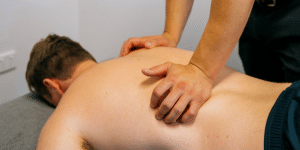Medial and Lateral Collateral Ligament Injuries (MCL and LCL)

What are the MCL and LCL?
The knee has a pair of ligaments running along the inside (medial collateral ligament, or MCL) and outside (lateral collateral ligament, or LCL) of the joint. These ligaments protect the knee against lateral movement and restrict it into a hinge-type motion. If a very high force is applied to either the medial (inside) or lateral (outside) ligament it can tear, with varying severity. The medial ligament is injured more often than the lateral ligament1.

In sport the medial ligament is usually injured as a result of an impact from the side or a slip where the knee buckles inward under bodyweight load.
Grading
- Small tear with no laxity
- Moderate tear with laxity
- Complete rupture resulting in gross instability

It is relatively common for people with grade 3 MCL or LCL injuries to suffer damage to other structures in their knee, especially the anterior cruciate ligament (ACL) and cartilage or menisci.
How are MCL and LCL injuries managed?
- Ice for 20 minutes, 5 times a day, for the first 72 hours.
- Compression to reduce pain, bleeding, and irritation of surrounding tissues.
- Bracing is essential for grade 2 and 3 injuries to ensure the ligament heals without laxity, which can cause recurring instability and loss of function.

Grade 1 Tears: Depending on the patient and their activity profile these injuries do not always need to be put in a brace. Symptoms resolve relatively quickly and returning to your previous function will take approximately 2-4 weeks with physiotherapy 2, 3.
Grade 2 Tears: A range of motion brace which restricts stress to the collateral ligaments will need to be worn ASAP to allow the ligament to heal. Returning to your previous function will take between 4-12+ weeks with physiotherapy depending on your physical function, concurrent injuries and your compliance with rehabilitation 1, 3.
Grade 3 Tears: You may be referred for MRI to confirm the diagnosis and exclude damage to other structures in the knee. Conservative management is effective, with bracing starting ASAP and in place for at least 4-6 weeks, plus a comprehensive rehabilitation program overseen by your physiotherapist. Grade 3 injuries associated with ACL and/or meniscal injuries will be referred to an orthopaedic knee specialist for review and advice regarding best management. This may include surgery, again depending on the patient, their activity profile and individual goals1, 3.
What will physiotherapy offer?
A physiotherapist will assess your knee, grade your injury and provide a range of motion brace if indicated. You will discuss approximate timelines for return to work and sport.
Through hands-on treatment, specific rehabilitation exercises and graded return to activity your physiotherapist can assist with reducing pain, regaining movement and rebuilding strength, power, and stability to permit a quicker recovery and safe return to sport 2.
Am I at risk of recurring injury?
A well-managed MCL or LCL injury should heal to 95-100% function. Participating in risky activities means there is always a chance of re-injury but with precautions such as supportive taping or light bracing in place there should be no reason to avoid returning to your pre-injury activity, including contact sports, skiing, and physically demanding roles at work.

If you have any questions or are experiencing knee pain, contact us here or book an online appointment today
References:
- 1. Schein, A., Matcuk, G., Patel, D., Gottsegen, C. J., Hartshom, T., Forrester , D., White, E. (2012). Structure and function, injury,
pathology, and treatment of the medial collateral ligament of the knee. Emergency Radiology, 19, 489-498. - 2. Carlo, D. M., Armstrong, B. (2010). Rehabilitation of the knee following sports injury. Clinical Sports Medicine, 29, 81-106.
- 3. Kovachevich, R., Shah, J. P., Arens, A. M., Stuart, M. J., Dahm, D. L., Levy, B. A. (2009). Operative management of the medial collateral ligament
in the multi-ligament injured knee: an evidence-based systematic review. Knee Surgery, Sports Traumatology, Arthroscopy, 17, 823-829.






